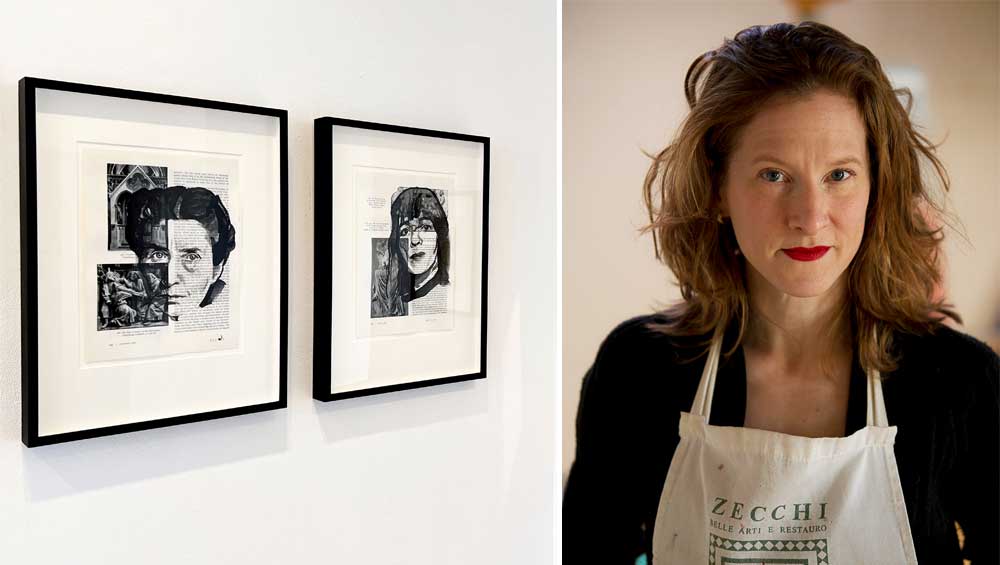
Coral Woodbury. Photo: Myke Yeager; installation view, Palimpsest, HackelBury Fine Art, London.
by CHRISTIANA SPENS
Coral Woodbury’s latest solo exhibition, at HackelBury Fine Art in London, presents three new interconnected works: Revised Edition, Palimpsest and In Place. In the first work, Woodbury draws over the pages of the art history textbook Janson’s History of Art, integrating female artists into its pages. In Palimpsest, she explores the transcendent nature of time and life experience, and how we can open dialogues with the past through engagement with books as well as nature. And in the series In Place, inspired by trips to Cuba and Nepal, she records her experiences and the ways in which engaging with other cultures can challenge how we think about ourselves and our political and social values. She talked about these fascinating, multilayered works, and the ideas and experiences that inspired them, via Zoom, from her studio, in an old mill that lies halfway between Boston and Providence, Rhode Island.
Christiana Spens: In Revised Edition, you take Janson’s History of Art as your starting point, and critically reinterpret it from a feminist perspective. What led you to choose this book, and how did you approach the project?
Coral Woodbury: Well, Janson’s is really the classic, even seminal, 20th-century art history textbook in the western world. Of course, it wasn't contextualised as the western world, it just defined art history … It’s probably the most famous art book ever written; it has sold millions of copies and has been translated into 15 languages. It defined the art history canon for generations of scholars, art historians, curators, students and artists, and so it really encapsulates what we know about art, how we think about art, even what we see as being art. The impact of it has been far reaching.
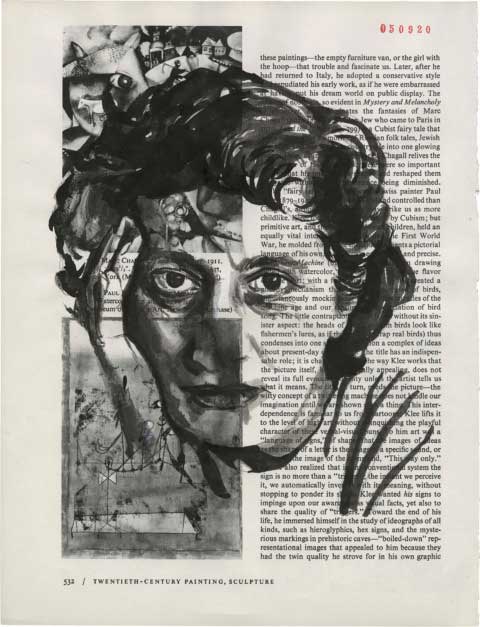
Coral Woodbury, Anni Albers, 2021. Sumi ink on book page, 11.5 x 8.75 in. © Coral Woodbury, courtesy of HackelBury Fine Art.
CS: Did you first come across it when you were a student, or earlier?
CW: It was funny, it wasn’t the textbook I had used as a student, but it was just so pervasively known at that time. I actually used Helen Gardner’s Art Through the Ages, which has been in print for nearly 100 years, but that was published in 1926 whereas Janson was published 1962. And Helen Gardner only lived only for the first three editions of the work, and it had a different approach from the beginning. Women were barely mentioned, but America’s art was at least present. She included other cultures in it in a different way and then, after she died, a different editor took over for the 1948 edition. In the case of Janson, his misogyny dominated its publication history. I think it’s just such a cultural factor, as well. I mean, you don’t even call it Art Through the Ages, you call it Janson’s! I think if you’ve done any feminist art historical reading, then you’re going to come up against Janson being this kind of brick wall. So, even though it wasn’t a textbook I had used as an undergraduate, it was culturally iconic and culture-defining.
CS: It’s funny you should say it’s like a brick wall, as it literally is like a brick – you know, the size of it!
CW: Yes, it was a good seven pounds, I think. I can’t even remember when I first encountered it; I probably encountered it first more critically or theoretically rather than having it in my hands, reading it. So, I knew about it before I even had it.
CS: You use ink on printed pages from the book to create your artworks and present a feminist message and revised history. Why did you use black ink, rather than red, for instance, or another colour?
CW: The book is printed in tones of black because almost all the illustrations are black and white, and in order to embed the women in the art history, they needed to be part of that book and they needed to be the same material, or medium as the book so they felt more integrated rather than superimposed. Any colour or media and the additional image would have sat on the top of the page. Those layers then wouldn’t have melded in such a way that they were each part of the fabric of the other, and truly integrated.
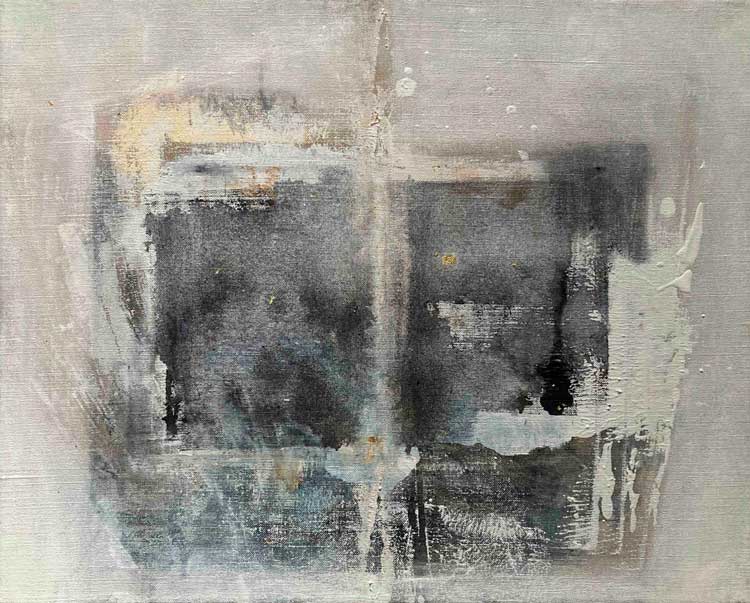
Coral Woodbury, Broken Spine IV, 2021. Oil, ashes, and gold leaf on linen, 16 x 20 in. © Coral Woodbury, courtesy of HackelBury Fine Art.
CS: Revised Edition is very much about reinstating erased lives and voices, along with your other projects, Palimpsest and In Place, which also delve into temporality and life experience and the language of colour. Can you tell us a little more about your efforts to make the invisible visible in these projects, and how they work together?
CW: For Revised Edition, it was about working against the very conscious and concrete erasure, enforced invisibility, of women from art history, and so my work is to make them less invisible, to shine this light of recognition on them. But the invisible, for me, goes beyond just what we cannot see to what we cannot know or understand with our rational mind, but which we experience or sense in different ways. Palimpsest is an exploration of the more mysterious aspect of what we cannot see. It’s time and memory built up in an object.
CS: In that sense, is it partly about loss and what we have lost in that history not being told a certain way or not being open to people in a certain way?
CW: While Revised Edition is a palimpsest, and I am making layers over the original pages and thereby transforming the original images, the palimpsests aren’t directly related to Janson, necessarily. While they can incorporate the sense of histories that change or are lost, it’s not specifically related to Janson’s or Revised Edition. It’s more about the experience of being human and about the frailty and longevity of memory, how it’s mutable, how memories change over time – the layering of thought experience and how, the processes of losing something, or something being scraped away or effaced, and then the layering on of something new, echo the human experience, and create all these shifting meanings.
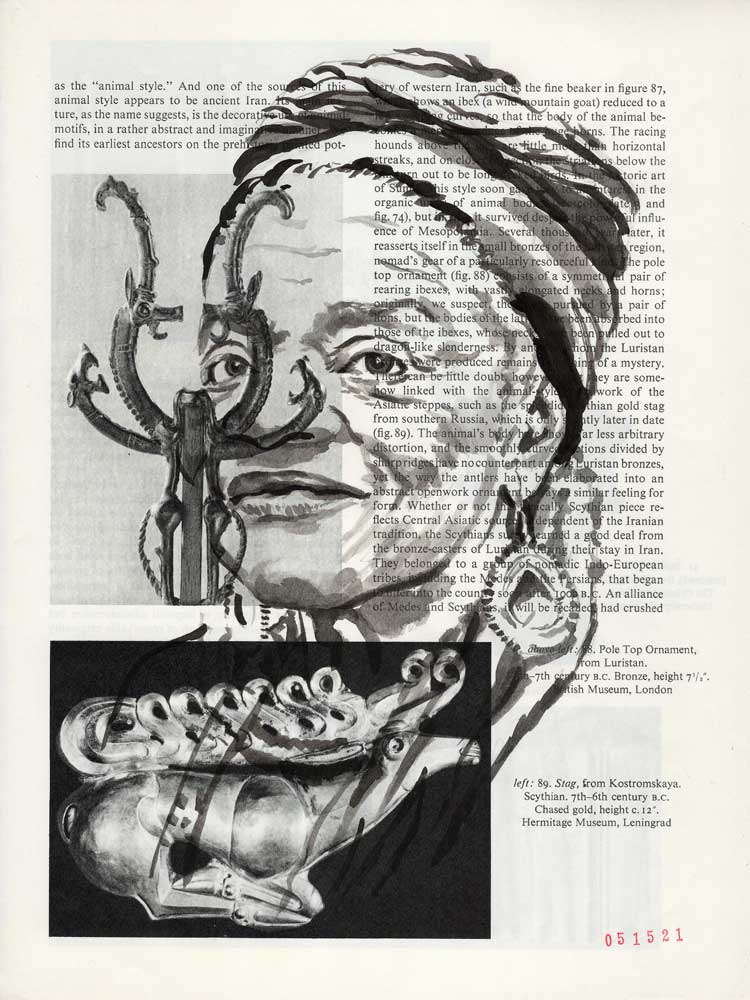
Coral Woodbury, Faith Ringgold, 2020. Sumi ink on book page, 11.5 x 8.75 in. © Coral Woodbury, courtesy of HackelBury Fine Art.
I’m really interested in these illegible marks. You’ll notice there are obscured texts, cryptic markings, those are actually from other kinds of palimpsests – such as heavily edited copies of books, from various authors such as Baudelaire and Proust. All those markings that are made are another kind of palimpsest, which records changes in language and thinking. I’m intrigued by this sense of meaning and memory that is transient and shifting, and knowableness, and yet they all make a tenuous hole that grows and fades and unifies and then dissolves. That’s how I think about the palimpsests – there’s an archaeology to them. The building up and then scraping away and removal echo some of the more mysterious aspects of being human.
CS: When you talk about the mysterious, our rational way of thinking and how that is its own constraint, it makes me think about the work of the US writer and activist Audre Lorde, her idea of the erotic as a force in society that has been restrained and repressed.
CW: Yes, we definitely share some of the same ideas. Scientific thought is only several hundred years old but it has been elevated to the point where it seems as if it’s the only way of knowing truth, superseding other ways of knowing and experiencing the world. That came about through humanism in the Renaissance, and also suppression by the church of more esoteric knowledge. And especially this sense of: “What’s bigger than us, what’s more than this, what connects us?”
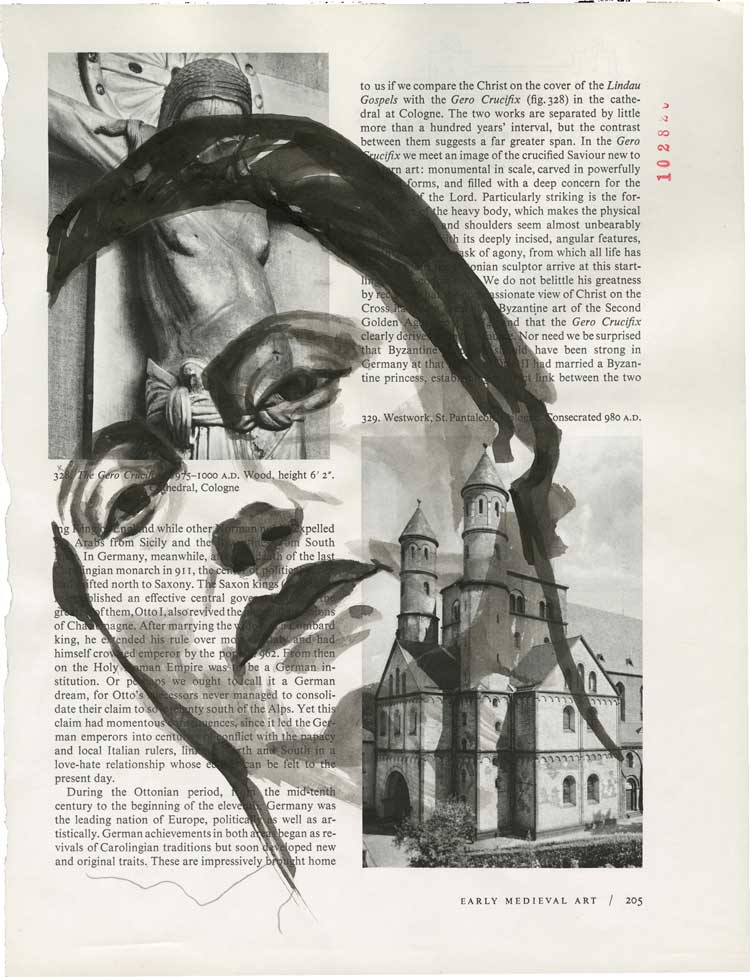
Coral Woodbury, Lotte Laserstein, 2020. Sumi ink on book page, 11.5 x 8.75 in. © Coral Woodbury, courtesy of HackelBury Fine Art.
CS: I suppose, also, what people are grasping at, when they’re trying to write things down, or change their mind, or have a dialogue.
CW: Yes, because these things, these forms of knowledge aren’t usually language based, and yet we’re so constrained by our own languages. I was reading this wonderful book called Braiding Sweetgrass, by Robin Wall Kimmerer, and it’s a book of indigenous wisdom in relation to the natural environment, and one of the chapters that was paradigm-shifting for me was when she was talking about learning the language, and how difficult it was – she was relearning her native language, and there are only seven speakers of it. And how difficult she was finding it because there were so many things that were verbs that didn’t make sense. Like, “to be a Saturday, to be a stone, to be a flower, to be a bay” – and it’s really the language of animacy, the language of all things, and all these other non-human beings. I live on a state forest, so I spend a lot of time walking around in the woods, which is such a meditative space, and I’ve realised how much of my thinking is shrunk by the constraints of my own language. There is no way in our language to see a tree as a being, for instance. But there are different ways of knowing that aren’t constrained or defined by western science, thought and language.
CS: Books have been a focus-point and key subject, as well as material and method, in your work to date. What draws you to books as objets d’art, or found objects, as well as tactile, interactive forms of communication and expression? Was there a beginning point to that method?
CW: I do use books themselves as a form of brush sometimes, so, yes, they’re method; they’re also metaphor, they’re resource. It’s hard to know when or where the impetus to use them in this way started. I think books, for me, represent the infiniteness of knowledge and understanding. I know you can’t learn everything from books, but they’re a symbol of that quest, that seeking of knowledge. Although everything is now on screen, I’ve always been drawn to old things, and books are among them in that way. Of course, some old manuscripts are also works of art in their own right too.
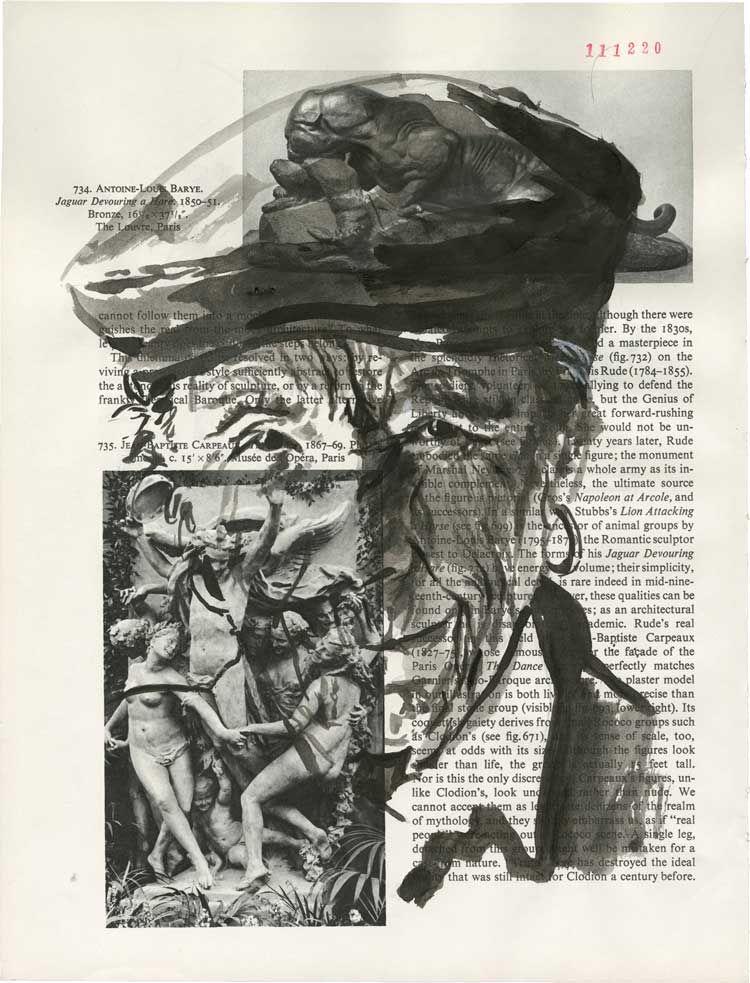
Coral Woodbury, Louise Bourgeois, 2020. Sumi ink on book page, 11.5 x 8.75 in. © Coral Woodbury, courtesy of HackelBury Fine Art.
CS: You were talking about trees as living beings; do you think of books in a similar way, even though they are man-made, since they often stand the test of time?
CW: Yes, they’re so beautiful in and of themselves, and they have these beautiful textures and colours. If you think about it, when you buy an old book from a used bookstore, contained within it are all the thoughts and words and feelings and labours and passions of the author, and then there’s also all the experiences of the previous readers, and everything they’ve brought to the book. The way it’s worn smooth by their touch or the life on their bookshelf – all that human connection is embedded in that book. It’s entirely unknowable to me – and this goes back to that sense of mystery we were talking about before – how all those previous life experiences have touched that book in some way. And while I can’t cognitively explain it or articulate it, it’s all still part of that book. So, they’re rich with symbolism and multiple meanings and layers of that story. I find them a fertile source of human story. And, some day, that book will be passed along, and I’ll have become part of it too.
CS: There is also a memento mori aspect to books, then?
CW: Exactly, that’s beautiful, perfect. And I’ve worked with memento mori in other incarnations of my work, but I think it’s all tied together, all these thoughts and interests, enduring. They keep coming up over the course of my work.
CS: In a way, that is its own sort of ritual in terms of how we process loss and death?
CW: Death is fundamental to the human experience, and without the certitude of our death, our lives would mean something very different.
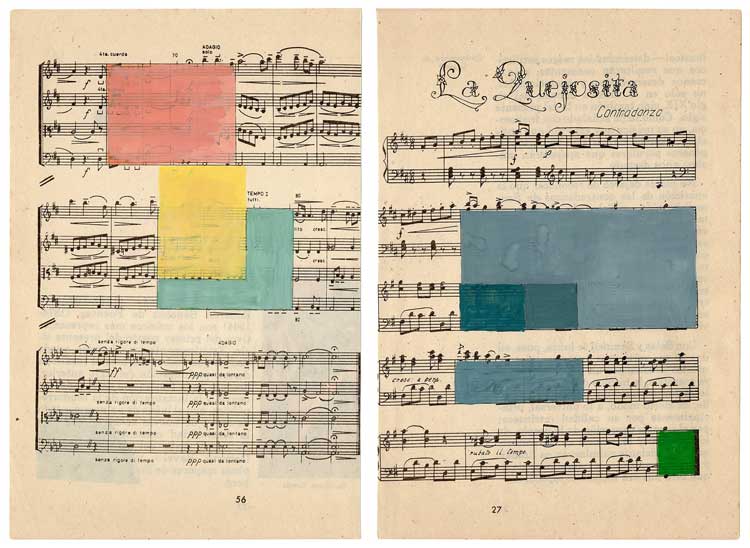
Coral Woodbury, Torrential Misadventure in 1951,Chevy Bus and Pedicabs, 2018. Gouache diptych on 1969 Cuban book pages, 7 x 10 in. © Coral Woodbury, courtesy of HackelBury Fine Art.
CS: I suppose, with the everydayness of books, they encapsulate the everydayness of death and loss, in a way, which is perhaps what we have lost as a society, by making death this terrifying, abstract thing?
CW: I think so, and the work I’m doing is approaching death, making peace with death. I think we all experience loss and death in our lives, and that was part of the impetus for some of this work. For me, these experiences really make you revaluate what you’re doing with your life, and certainly the uncertain time that we have, that we’re given, and what we’re doing with it, and how we want to live, and who we want to be, what values guide us in our lives and how we make peace with the guarantee of our death. We’re here for such a short time.
CS: Has coronavirus changed accentuated or exaggerated that feeling?
CW: I would say that it hasn’t impacted me in that way because I feel like I was facing this in a pivotal and life-changing way just less than a decade ago, so it’s been something that’s already been in my thoughts and personal work and reflection and so maybe I … I’m also losing my words! Talking about death …
CS: Isn’t that funny though? It is what you were talking about before, that words are not enough to explain things, so there is always something incomprehensible, or at least very difficult to articulate accurately or precisely. I wrote an essay about drawing still lives, flowers, after my father’s death, and how meditative it was, and it occurred to me how different that was to the big drama of death itself, but also a pandemic like this, where everything is very hyped up, and it was interesting to go back to thinking about an activity that is so slow, in a similar way to reading and walking, and this is across cultures.
CW: I think that is definitely something that’s happened in the pandemic, it’s shown us how much we’re all connected, and how much we share in this human dilemma, and how fragile we all are, and how complicated it can be to communicate that.
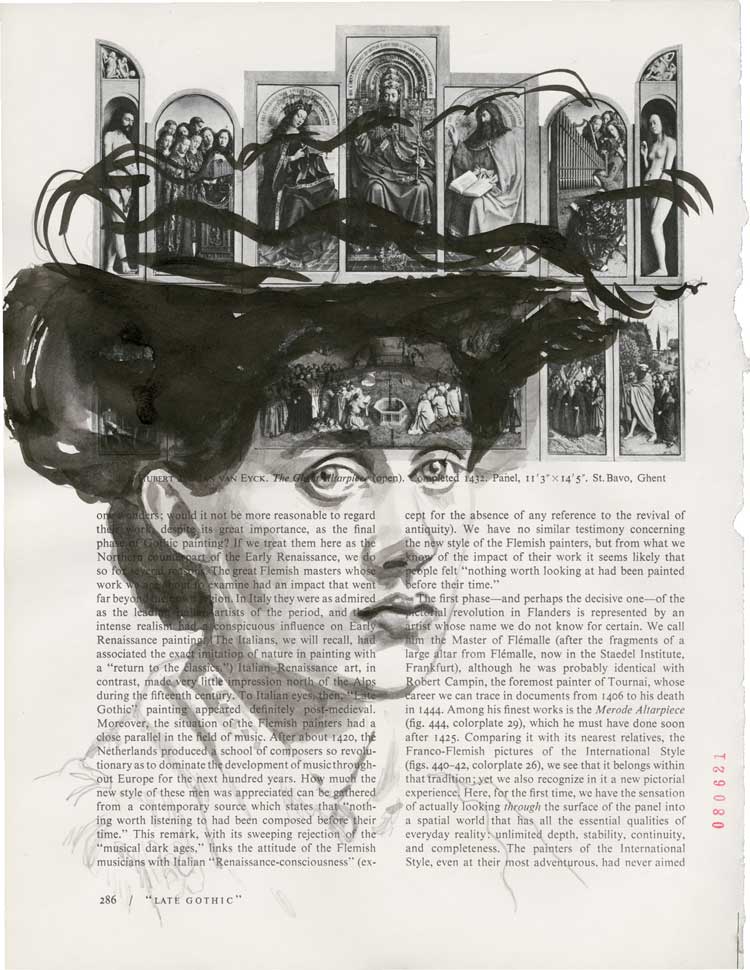
Coral Woodbury, Vanessa Bell, 2021. Sumi ink on book page, 11.5 x 8.75 in. © Coral Woodbury, courtesy of HackelBury Fine Art.
CS: Have books, in your work, become a metaphor also for this fragility, since they can be very fragile, especially old books?
CW: Yes, and yet they’ve endured, especially those made of parchment, and old books in general, they’ve endured, often longer than us. We’re not talking about paperbacks, but it’s not uncommon for books to be 100 years old. They actually have a longevity that can surpass our own. That’s one reason the parchment manuscripts were reused – because the parchment was so durable. Both the stories that are contained in them, and the reprinted and rebound editions, and the books themselves, can endure surprisingly long, even millennia.
CS: In some of your works, you use gold leaf, which recalls the Japanese practice of kintsugi, the repair of ceramics with gold that highlights and honours the history of breakage. How have you used this visible reforming of breakage in your own work? Are you revealing fragility, and is this also a comment on human nature and development over time?
CW: Yes, definitely. For me, this practice and process are a metaphor that breakage and destruction can allow growth to happen. There is beauty in the broken places; something about falling apart can allow for new growth or healing in a different way. There are so many parallels – in nature, in art, in our own spirits.
CS: Can you tell us about your travels to Cuba for its unofficial and unsanctioned biennale in Havana, which informs your work In Place? How did these journeys challenge and expand your existing practice?
CW: Well, this biennale in Havana, because it was independent of the state it was seen as counter to the state and was really repressed. There’s also an official biennale, but a lot of international artists are boycotting it because of human rights abuses. My friends have been thrown in prison and left there for months at a time. Basically, they have no freedom of speech, no freedom of expression, they cannot make their work. They don’t have state permission to make their work, and if their work challenges the state, they’re thrown into jail or kept under house arrest for months at a time, not allowed to leave, with a guard in the lobby of their building.
It’s really awful. And I was completely ignorant of this, going into it. And I learnt a lot more about it after I left as well and have continued to keep my eye on the crisis on the ground, as much as I can. These artists are making work with what they can – there are very few art stores, and most of them are closed. When they’re open, they’re mostly empty, and so work was made with human hair or discarded clothing. It really was a striking demonstration of the importance of art to the human spirit. Art has power, and dictators always try to silence artists and that’s what I’ve seen happening in Cuba. That trip reminded me of the real power of art, not just metaphorical, but political.
• Coral Woodbury: Palimpsest is at HackelBury Fine Art, London, until 22 January 2022.
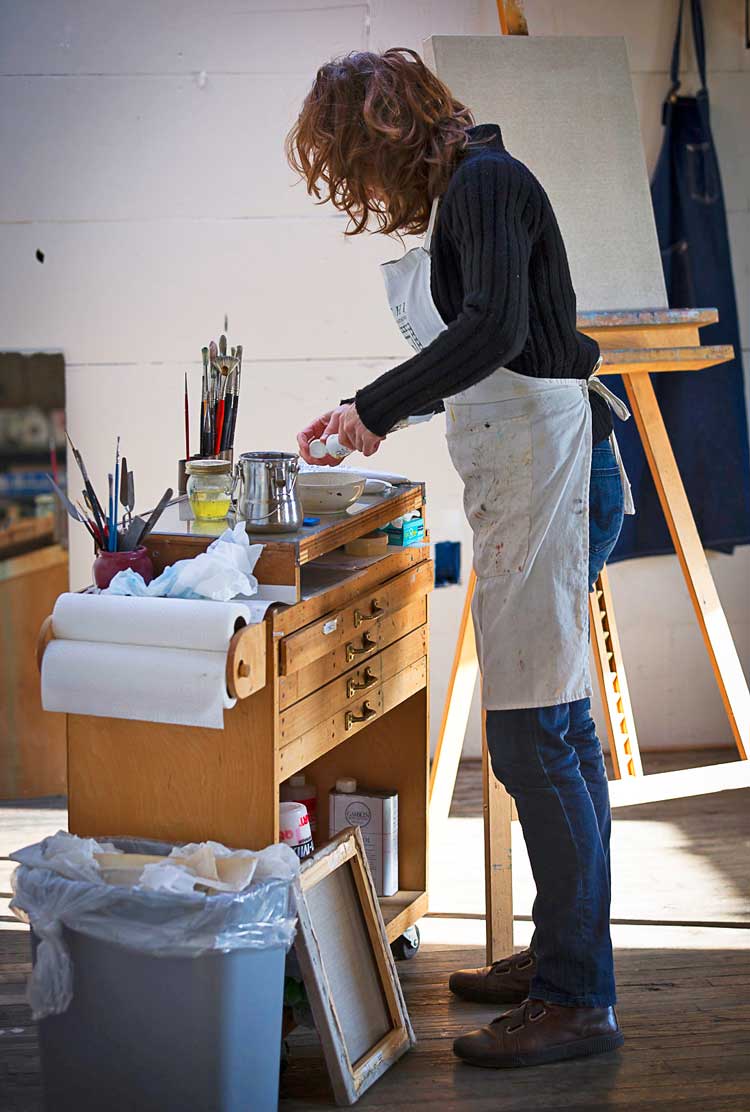
Coral Woodbury in her studio. Photo: Myke Yeager.
Click on the pictures below to enlarge